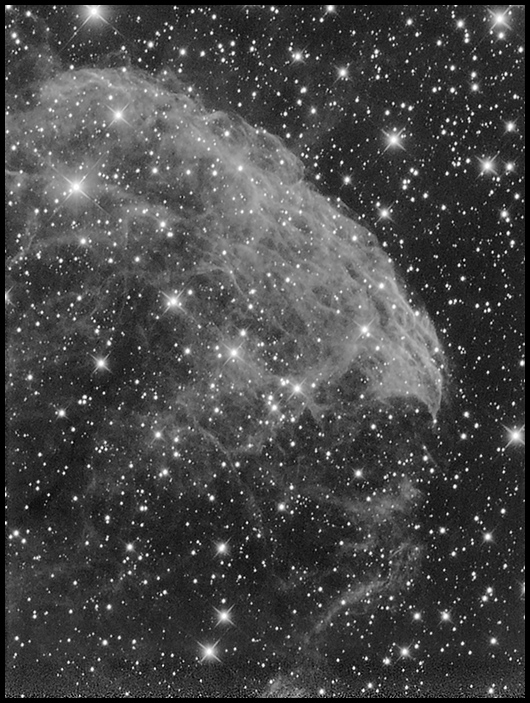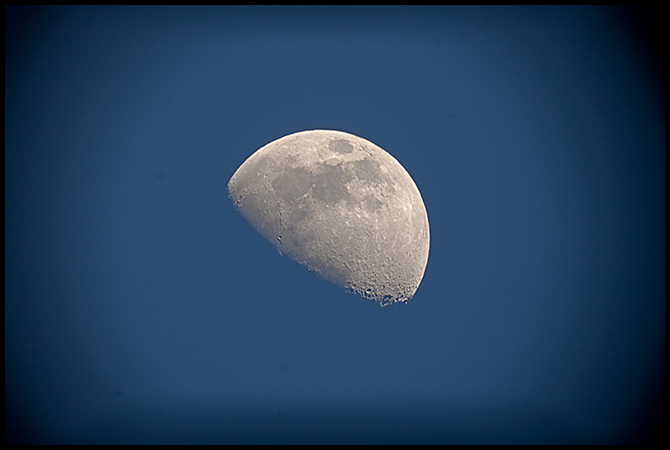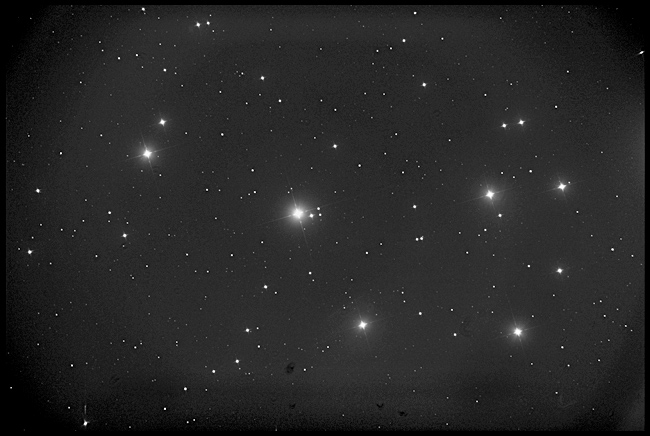12/29/2011. Anthony Frushour (geology, ASU) dropped by to visit, talk astronomy, and help rebalance the Ritchey. With the guide telescope bracketry simplified and the 9x60 finder mothballed, the telescope was pretty far from balanced in RA. I'd hoped to get rid of the bronze counterweight, but no such luck. I removed weights while Anthony held on in case the OTA decided to move while grossly unbalanced. In the end, We moved the 10#, 18# and bronze mystery weights a few inches up the counterweight bar and called it good. Two 18 pounders near full extension would do the trick, but other than lightening my wallet, I'm not sure what advantage would be forthcoming.
I set the telescope in Park 1, then synched on Deneb, and when darkness fell, I added a couple of extra L frames and an RGB sequence to NGC 7331:

NGC 7331 and the Deer Lick Group
14x900s L, 1x900s RGB
When NGC 7331 and its posse set, I returned to IC342 for more luminance. The sky is not as transparent as last night's, and though I collected another hour of exposure, it is of no net benefit. Friday night is a lost cause, but Saturday night is forecast to be excellent.
12/30/2011: I'm neglecting too many tools. I came to this realization after talking with Anthony yesterday about the software used for imaging at App State's on-campus and Dark Sky observatories. Since naming the DSI Pro as my starting guide camera, I've neglected the built-in ST-237 guide chip in the ST2000XM. I don't think PHD Guide can use it, and I am sure that Nebulosity can't access it while taking data from the main chip. But MaximDL can use both, and this may make it worth putting up with the extra complexity (I also get more familiar sequence scripting into the bargain). So that's the obvious solution for telecompressed guiding, at least in the L channel and in most wideband color imaging, too. It may not work behind the 7nm H-a filter, so it's still worth fiddling to get the seperate guidescope working well.
Speaking of that, here's all the paraphernalia I pulled off the top of the Ritchey (left, below). Since it all comes off the top and since the counterweights have moved closer in, I think the savings in rotational inertia are more significant than the weight loss. The cover fits better and with fewer snags. I cobbled up some brass sleaves or buttons (ten minutes with a chop saw and lathe, taking my time) to help the 3-point Losmandy ring support the guidescope's drawtube.
 |
|
 |
Retired finder and guidescope attachment hardware.
|
|
Brass buttons to help one remaining 3-point ring support the drawtube.
|
Worth remembering: steel bolts make quick work of shallow aluminum threads. Two of the holes in that now-retired aluminum ring were stripped by my modest efforts to tighten them, and that must have contributed to my inability to really lock down the guidescope. We'll try this new arrangement right soon. At the very least, adding extensions to the 3-point screws was an excuse to add brass to a telescope, and that's almost always a good thing, right?
12/31/2011: The Off-Axis Guider developed some play last night despite the SuperGlue. Today I pulled everything apart, tightened set screws and re-glued a few critical joints. I installed a 0.67x Astro-Physics telecompressor on the CCD in lieu of the OAG assembly. Icleaned all the filters while I had things torn down. Then I temporarily moved the DSI Pro guide camera to the ST80 guidescope to try imaging with the Ritchey at reduced focal length.
I began with great hopes which became great expectations when the CCD came to a tight, solid focus. I aimed at M33, opened the shutter for 900s and downloaded a mess. Dreadful trailing. I wasted an hour trying to remember how to make MaximDL watch the guide chip in the ST2000XM while taking data from the main chip. I was ticked off and exercised about the whole damn thing, so I probably didn't bring my best effort to making this alternative work, and I got lost in a maze of twisty little passages with respect to guiding and calibrating and exposing. It remains an obvious and should-be-easy fix for wideband imaging.
I took a lot of short (5 minute) frames of M33, ending with some color data, and then moved on to IC443. I took 5 min exposures of it all night long and will let CCD Inspector describe what's happening. It's an engineering exercise, and if some pretty images come of it, better. I took 20 minutes of RGB in the middle of the run (Happy New Year, gang) intending to work that up tomorrow, but screwed up: I never downloaded the color data; I erased it and overwrote it with the rest of the night's luminance -- not the happiest start to the new year.
Here are my first night's efforts at a measured 1400mm (F5.6); image scale 1.09" per pixel (vs 0.77" per pixel at the R-C's native F8):

M33
AT10RC @ F5.6
20x300s L, 3x300 sRGB

IC 443
42x300s L
AT10RC @ F5.6
The A-P 0.67x telecompressor works exactly as advertised. I have it screwed into an A-P nosepiece and then into a Mandel muscle plate on my ST2000XM. It produces a focal length of right at 1400mm, for an effective F-ratio of F5.6. The focuser is extended about 1.5 inches farther than the 1/4 inch it is extended with the OAG and no telecompressor. Note that it is worth trying to use the OAG with the telecompressor. That's much more extension than I anticipated, and there might be enough room to put the compressor in front of the OAG afterall. I still doubt it, but it's worth checking [does not work out, see below].
I am about 95% convinced the sag is not in the guider. My suspicions have settled on the focuser (most likely) or the primary mirror mount.
Some morning-after experiments suggest that the extra focuser extension may be a (large?) part of the problem. Simply tightening the focuser's clamp bolt judiciously removes a lot of flex (with this clamp completely loosened in deference to RoboFocus, I can feel and see movement in the extended drawtube when I apply sideways force to the CCD, and most of it goes away as the clamp bolt is tightened). The bolt has a Delrin tip and RoboFocus can move the focuser with some clamping force applied. Mess with this, and your problem may be over. Wax it, lube it, or put a Teflon tip on the bolt if a little more pressure would make all the difference. Also, note that there is room to put the 1-inch extension back in place for telecompressed imaging, and that would eliminate much of the focuser extension and perhaps much of the problem.
In the worst case, use the 1-inch extension for telecompressed imaging, attach a Losmandy 3-point ring to it, and engineer braces to immobilize it (maybe with a rig akin to this fix). Another possibility, because the focuser is attached to the mirror cell, would be to install clamp bolts to press against the mirror mount as is often done with C11's. (Note that even if the OAG does work behind the telecompressor, the camera is still moving at the focal plane or the mirror is shifting some, or both; either way, collimation is going to be compromised whether or not the OAG compensates for the image motion. So even if the OAG solves the immediate problem, it's worth finding and fixing whatever is behind this.)
Listen, it's a strange world in which I am pissed off with tonight's results. Less than a year ago, I would have been thrilled with these images, but now I want 900s subs with round stars (and no need to deconvolve images to get them). 600s at the very least. That's what it will take to do effective narrowband imaging at this shorter focal length.
1/1/2012: On tonight's docket, the simple fixes. I gently tightened the focus clamp and made 900s and 300s exposures of M33. Better in each case. Then I cinched the focus lock down and repeated the exposures. Much better! The 300s frame is solid; the 900s is about as good as yesterday's 300s. A 600s trial was useful. I found, however, that really locking down the drawtube changed the focus too much (no, maybe, could be, see below). So I put the 1-inch extension on the telescope (in the dark with my left hand while holding the CCD with a deathgrip in my right) and tried again with the focus lock lightly clamped and the drawtube much less extended. This is looking good, and we're on the right track. That said, seeing is awful and wind has begun to swirl. I took the dew shield (aka "the sail") off the telescope. Gusty wind is unusual down here in the pines but we've got it tonight. The guide star is getting kicked around 3 and 4 pixels (10 arcseconds or more) at a whack. Look:

Even so, what I see in the downloaded data seems encouraging -- little or no underlying drift to the left or right, but really, what can I tell when stars look like balloons and the tattletale graph looks like an (extremely alarming) EKG?
Later: down the western sky we go. Wind has settled down, seeing has improved. And we're picking up gobs of drift. I cinched down the focus lock again between exposures to see if that's really a problem (why would it be? it's worth being sure). Ffocus did not go to hell (or at least not much beyond an outer circle), but trailing is still a real problem. Seeing remains pretty bad (2.5 - 3 seconds). I'm swatting at gnats here, flailing away without a plan, etc. I am about ready to admit that Drew's Law is real:
Mon Nov 14 2011
(http://observers.org/tacimg.mailing.list/2011/Nov/0106.html)
I posted (as part of a completely different discussion in another group) this whimsical Law, sort of like Parkinson's law:
The longest subexposure you can take while using a guide scope is, in seconds, equal to 400 times your image scale in arc seconds/pixel.
As some examples (all with an STL11K and 9 micron px):
- Tak FSQ+Reducer (FL 385mm) Image scale 4.82"/px x 400 = 1926 I.e. you can take a 30 minute sub.
- AP 160 (FL 1205mm) Image scale 1/54"/px x 400 = 615 You can take a 10 min sub but not a long (20 or 30 minute) Narrowband sub.
- Planewave 12.5" (FL 2541mm) Image scale 0.73"/px x 400 = 291. A 5 min sub is about all you can take before you start to see elongation.
Note with a smaller px camera (ST-10) you will see elongation sooner. Note too this assumes you have good seeing (FWHM 1.5 to 2.0"). If your seeing is in the 2.5 to 3.0" range the seeing will blur minor elongation so you can go a bit longer.
The rule of thumb sounds whimsical but is surprisingly close to what I actually get. And I don't find it correlates at all with mount or OTA, only with image scale, seeing duration of sub.
Drew S.
|
If Drew is really onto something, then I am expending way too much time and effort trying to guide 900s subs at this image scale with a separate guide 'scope. 400 * 1.09 = 440. With my smaller pixels (7.2 micron), I should stick to 300s exposures and find some other way to guide narrowband, telecompressed images with the Ritchey. Or just don't make such things. Maybe I should just decide that if I want wide angle images at selected wavelengths, I'll use the refractor. The Ritchey works at F5.6 except for narrow-band imaging (which requires much longer subs). That's no small success, and it might be all I'm going to get from a separate guide 'scope.
I'm going to finish the night with 300s exposures and think about this. No. I'm not. Seeing is dreadful, the air is not particularly clear, the Moon is bright. I'll not have anything for show and tell anyway. I'm closing up shop and I'm not even going to think about it. Much. Maybe I'll set up the off-axis guider behind the telecompressor for one more attempt to use the Ritchey at F5.6 for longer subexposures tomorrow night (but only if it just flat works, no messing, no adjusting, 'cause that way lies madness; now that I have the OAG working well at the native FL, I do not want to frig it up).
1/2/2012: The forecast is for clouds early, poor seeing later. And very cold by local standards. It's a good night for measurements but not for pretty pictures. No matter the details of the sky conditions, if I have any stars at all, I can still determine if the CCD will come to focus behind the OAG. [No; t's not even close.] If it does, I can make sure that the OAG focuses as well.
I've never tried the Canon 5D behind this telescope (or any telescope) so enamored have I been with the CCD. So I've set out the pieces to try imaging on its much larger sensor (about 3x larger in each dimension than the KAF-2001 in my ST2000XM). The full-frame (24x36mm) Canon should be comparatively forgiving of both seeing and guide errors. And since five minutes is a reasonable subexposure with the DSLR, guide errors shouldn't be a problem under even the most conservative of Drew-like laws. The Moon, for scale and plausibility:

Waxing Gibbous Moon
AT10RC, A-P 0.67x telecompressor
Canon 5D
Look at the mighty darkening in the corners; note the crisp central detail; see the clean blue sky... after this, I shot several sky flats in hopes of minimizing the strong vignetting in case I get the chance to aim at some clusters tonight.
Too cloudy, too moony to do much more than make a few measurements. With the 0.67x A-P CCD telecompressor on a short 2-inch prime focus adapter mounted in an EOS T-adapter, I get an EFL of 1330mm (F5.3) and a pixel scale of 1.27"/pixel. Guiding is spot-on for 300s subs. Field curvature is (only) 25%, but stars are big owing to poor seeing (check that again on a quieter night). I'm not sure the entire frame can ever be pulled out -- the corners are likely to be eternally shaded with these adapters and optics. This configuration comes to focus with the drawtube extended to about 4cm. The smaller sensors of the crop-frame cameras may be better suited to telecompressed imaging while the full-frame 5D might be a better fit for the Ritchey's native FL. Check to see how large the useful field in the 5D is and how it compares to the crop-sensor bodies.

M45, 1x300s
AT10RC @ F5.3
Canon 5D w/A-P 0.67x telecompressor
Poorly flatfielded, obviously,
plus some moonlit cloudiness.
I parked the telescope in the vicinity of the north celestial pole and came inside to find the guider field. It appears to be centered a degree and small change from the main ota's point of aim, a misalignment that should matter little with good polar alignment and that can probably be adjusted out using the 3-point ring holding the drawtube. Three-second guide integrations show clear 11 - 11.5 stars that would make good guide stars; 9.5 stars look ideal. With 10 second integrations, I can see 14th magnitude stars easily. I renew my amazement at how tenacious this setup can be: earlier this evening, PHD Guide had a firm lock on a 7th magnitude star despite clouds thick enough to hide everything but the Moon and a dim and murky Jupiter.
While prepping the telescope to mess with the DSLR, I took a good look at the focuser. I wonder if it would be helpful to install some teflon spacers/runners to take out the sag noted during yesterday's trials. It looks like it should be easy enough. [1/9: parts on order, stay tuned]
1/4/2012. I caught another econo-OAG on sale on AstroMart. I'm thinking that I will leave the generally tamed Orion well enough alone and use this new-to-me Celestron model as a starting point to fit that 0.67x CCD telecompressor onto the ST2000XM. If I whittle, cut, turn, clamp, drill and tap enough fittings, adapters, and assorted kludges, I'm betting I can get the compressor, the pick-off prism, and the two cameras to line up in focus. It will keep me entertained, and between the clouds and the Moon, it may be the best way to keep my hand in for a while.
Except where noted, deep-sky photos are made with an SBIG ST2000XM CCD behind a 10-inch Astro-Tech Ritchey-Chretien carried on an Astro-Physics Mach1GTO. The CCD is equipped with Baader LRGB and 7nm H-a filters. A Meade DSI Pro monochrome camera looking through a modified Orion off-axis guider keeps the OTA pointed in the right direction. The imaging camera is controlled via Nebulosity 2; the guide camera is operated by PHD Guide 1.13, both by Stark Labs. The stock focuser on the AT10RC has been augmented with Robofocus 3.0.9 using adapters turned on the lathe downstairs. Maxim DL5.12 performs image calibration, alignment, and stacking; Photoshop CS4 and FocusMagic 3.0.2 take it from there. Gradient Xterminator by Russell Croman and Astronomy Tools by Noel Carboni see their share of work, too.
:: top ::